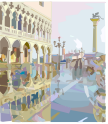


What is “style”?
Consider the difference between the buildings in these three pictures:



Built at different times, in different places and to suit different needs and tastes, these buildings differ in style. We see this difference in the size, layout, shapes and colors of the buildings.
Similarly, as a writer, you can and already do adapt the style of your writing to suit the audience and purpose for which you are writing. For example, text messages are necessarily short and to the point, while holiday newsletters are often chatty. Writing for business memos and newspapers tends to be characterized by short paragraphs because it is intended for readers who often scan most of the text and only read some of it carefully. Academic writing, on the other hand, tends toward longer, more developed paragraphs.
Just as the designers of these buildings created a certain style in their choice and use of materials, so you can alter the style of your writing in the materials you choose. A builder works with wood, class, stone and steel to create a style. A writer works with words, grammar, sentence and paragraph structure to shape the style of their writing. For example, compare the effect of word choice and sentence structure in the following three sentences all conveying the same basic piece of information:
She said to come here.
“Y’all come over here,” she yelled.
The lady bellowed most indecorously to the young people, requesting that they join her forthwith.
Now, consider these three buildings:



These pictures are licensed under the GNU Free Documentation License . They are from the Wikipeida article on Frank Gehry .
They are the Guggenheim Museum in Biblao, Spain; the Pritzker Pavilion, a band shell in Chicago’s Millennium Park; and the Stata Center at MIT. Designed for different purposes in different places, they also share common stylistic elements that let us know they were all designed by the same architect, Frank Gehry. Even though Gehry changes some stylistic elements to suit the needs of the building, he also retains others that become ways to identify his style, no matter what he is designing.
Similarly, writers adapt their style to the different contexts in which they write, but also develop certain stylistic devices they carry across their writing. The goal is to be in control of these devices so that they are tools you use intentionally, rather than writing “tics” or error patterns that creep into your writing without you realizing it.